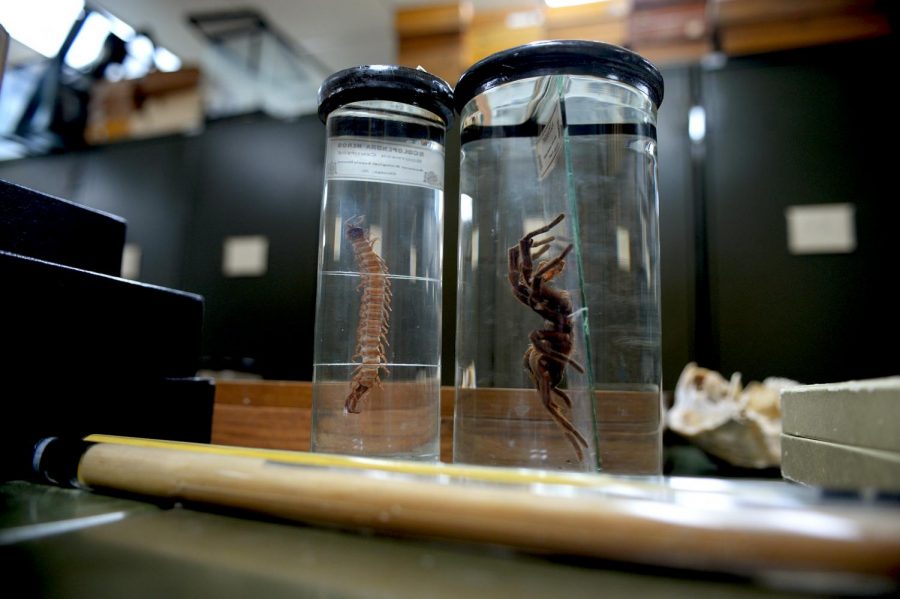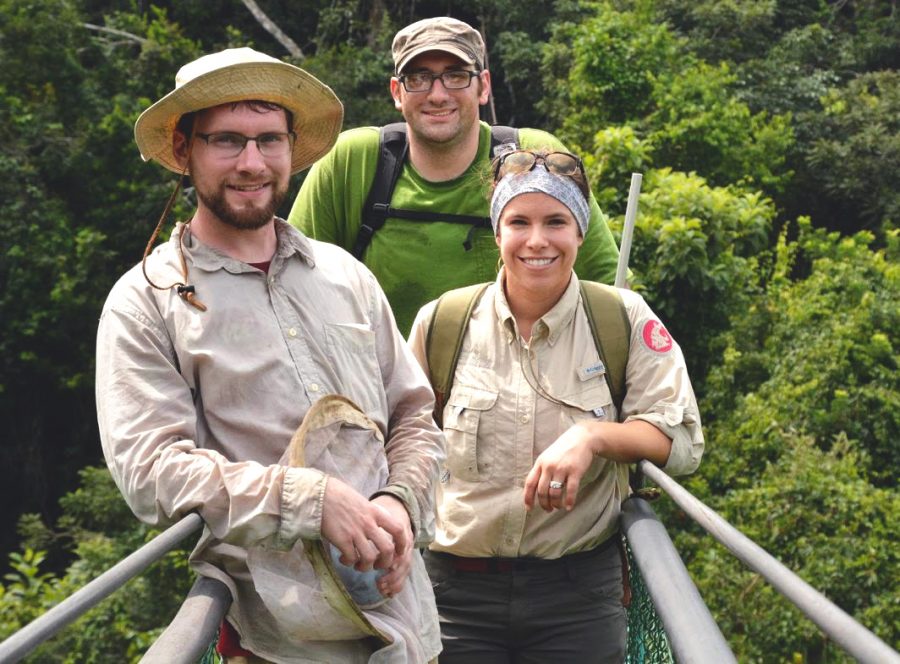WSU entomologists return from insect expedition
Entomology students travel to Guatemala on weeklong bug hunt, collect hundreds
CODY COTTIER | The Daily Evergreen
A centipede and tarantula stored in jars in the insect museum. More than 3 million bugs fill the lockers behind them.
October 27, 2017
Most of the megasomas, carrying their bulky bodies through the air, could only make it within a few feet of the insect trap — a white sheet strung between poles in the Guatemalan rainforest and illuminated under a blacklight.
But one bold beetle, the size of a human hand, hurtled by Alix Whitener and into the sheet.
“I thought she was gonna knock the whole thing down,” Whitener said. “It was like having a cannonball just whizz past your head.”
Whitener and two other WSU entomology graduate students returned from their weeklong insect-collecting trip on Sunday, each with two female and one male megasomas. The creature is commonly known as the elephant beetle, the largest insect in North America.
Entomology professor Richard Zack, who led the trip, borrowed one from a student to show in class. He released it on a metal countertop in WSU’s insect museum, of which he is curator.
It dragged its massive body with each step, unable to find its footing on the foreign surface. It seemed helpless, but the beetles are powerful. Whitener said one of these “really impressive insects” ripped through the sleeve of her shirt as she held it.
Adrian Marshall, another of the students, recalled his experience with the megasoma.
“You could really feel it when you caught it,” he said. “A lot of strength behind it.”
The elephant beetle was perhaps their most attractive catch, but the students caught and collected hundreds of other insects during their forays into the humid cloud forests of Central America.
In between trips to the Mayan ruins of Tikal and parks with names like Ixpanpajul, they spent their days scouring for bugs, and their nights alertly watching the insect trap.
Joshua Milnes, the third of the students, said the trip harkened back to childhood fantasies of adventure.
“Running around with the butterfly net?” he quipped. “I mean, that’s the life.”
They heard howler monkeys, saw vibrant quetzal birds and held beaded lizards. But they also found — to name a few insect families — ascalaphidae, corydalidae and membracidae, one species of which has something like deer antlers protruding from its head.
“The cool part,” Marshall said, “was going down to Guatemala and seeing all these insects that I’ve heard of, but only seen in books.”
Zack, the professor leading the trip, has ventured into the rainforests for the past 15 years, collecting insects for WSU’s M.T. James Museum, which boasts somewhere between 3 and 3.5 million specimens.
He said the collection’s main goal is to be representative of the Pacific Northwest, so people who need to study or compare insects to those in the region can use it as a resource.
But over the more than 100 years since the collection began — the earliest specimens are labeled as found in “Washington territory,” rather than “Washington state” — projects in places as far away as Micronesia have brought insects to WSU from around the world.
The collection, stored in drawers stacked twenty high in several rows of lockers in the Food Science and Human Nutrition Building, is open to tours and inspires awe in many who visit it.
“It’s like going to Disneyland for me,” Milnes said.
Zack said he, along with students and various collaborators, add 35,000 to 50,000 specimens to the collection each year. It is essentially a vast database, with information that people can reference when they don’t have firsthand knowledge of an insect.
“There are so many species of insects,” Zack said, “that nobody knows even a small percentage of them.”
Nevertheless, Marshall said that when they couldn’t identify a bug in Guatemala, Zack — who has curated WSU’s collection for more than 30 years — often had the answers.
“We’d bring it to him,” Marshall said, “and he could just on the spot tell you what it was the majority of the time.”
During what he called “an intense trip,” Marshall said they only slept a few hours each night. They sometimes took midday naps to compensate, or slept in the car while driving to a new site.
“You’re traveling the countryside and don’t want to miss anything,” Whitener said, “but you’re also running on three hours of sleep.”
This is because different insects are active at different times of night, she said. They come in waves from dusk to dawn, so the students stayed up to catch them.
“We wanted to make sure we were there for all these stages,” Whitener said.
Once they catch the insects, Milnes explained, they put them in “kill jars” filled with ethyl acetate, a chemical that “bumps off” the insects. They store the delicate specimens carefully until they can pin and sort them for collections.
In addition to studies and comparisons, Whitener said they use many of these specimens as visuals to make public outreach events more exciting.
Zack said that during expeditions, he may collect 10,000 insects, many unknown to science. The students on this trip collected several hundred each.
“For me, I think it’s all about discovery,” Zack said. “Every time we make a trip to Guatemala, we come back with material. A lot of it is new species.”
They don’t know yet whether they discovered any on this trip, as it takes time to check new finds against previously collected specimens, but it’s not unlikely.
The students all recalled the beauty — and oppressive heat, and aggressive fire ants, and frequent rains — of Guatemala, unanimously agreeing they would return if the chance arose. Milnes described the week of insect hunting as a “heavenly experience.”
“Once you catch the collecting bug,” he said, “you always want to collect.”










